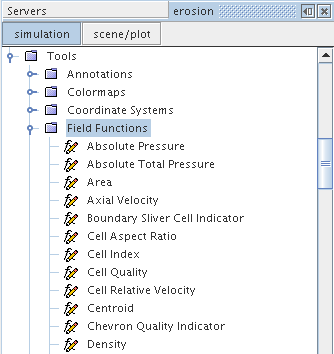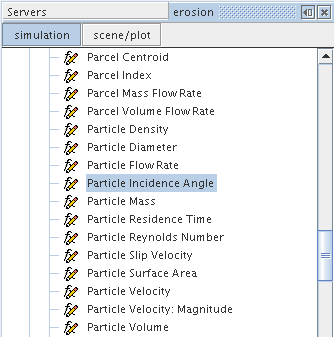Defining Field Functions for the Restitution Coefficients
Create field functions to represent the restitution coefficients.
Restitution coefficients are used to predict the angle with which a particle rebounds off a solid wall. In this tutorial, the relations that were developed by Forder et al. ([967]) are used:
Represent these equations in Simcenter STAR-CCM+ using user field functions. The quantities referred to in user field functions must come from the predefined system field functions or other user field functions. In this simulation you require a predefined system field function for the particle incidence angle.
To define field functions for the restitution coefficients:
-
Open the node.

-
Scroll down the list until the
Particle Incidence Angle function is visible.

-
Select
Particle Incidence Angle and note the value of the
Function Name property.

Having noted the required name of ParticleIncidenceAngle, it is now possible to create the function for the Normal Restitution Coefficient.
-
Right-click the node and select from the pop-up menu.
A new User Field Function 1 node appears in the object tree.
- Rename User Field Function 1 to ENormal.
-
Select
ENormal and set the following properties:
Property Setting Function Name NormalRestitutionCoefficient Dimensions Dimensionless Definition 0.988 - 0.78*$ParticleIncidenceAngle + 0.19*(pow($ParticleIncidenceAngle, 2)) - 0.024*(pow($ParticleIncidenceAngle, 3)) + 0.027*(pow($ParticleIncidenceAngle, 4))
The same steps are now repeated for the tangential restitution coefficient.
-
Right-click the node and select from the pop-up menu.
A new User Field Function 1 node appears in the object tree.
- Rename User Field Function 1 to ETan.
-
Select
ETan and set the following properties:
Property Setting Function Name TangentialRestitutionCoefficient Dimensions Dimensionless Definition 1 - 0.78*$ParticleIncidenceAngle + 0.84*(pow($ParticleIncidenceAngle, 2)) - 0.21*(pow($ParticleIncidenceAngle, 3)) + 0.028*(pow($ParticleIncidenceAngle, 4)) - 0.022*(pow($ParticleIncidenceAngle, 5))